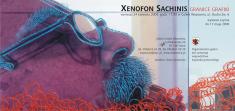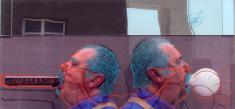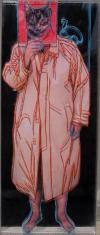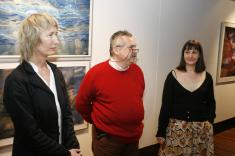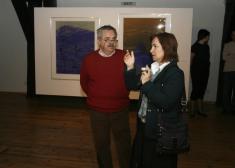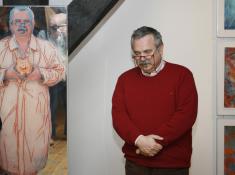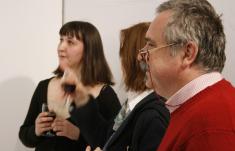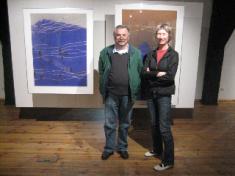26.04.2009
Xenophon Sachinis w Wozowni w Toruniu
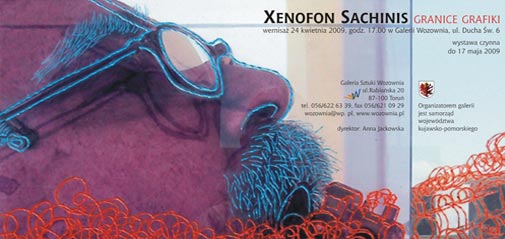
Xenophon Sachinis
âGranice grafikiâ
24.04.2009 â 17.05.2009
www.wozownia.pl
Prace Sachinisa sÄ silnie powiÄ zane z teoretycznym namysĹem nad specyfikÄ technik graficznych. Artysta nie tylko tworzy grafiki o okreĹlonych cechach stylistycznych, ale co bardziej istotne, w samych pracach eksponuje mechanizm ich powstania. W tej kwestii kluczowe jest podniesienie statusu matrycy, ktĂłrej rola postrzegana byĹa zazwyczaj jako sĹuĹźebna wzglÄdem odbitki.
Artysta urodziĹ siÄ w Salonikach w 1954 roku. StudiowaĹ na Akademii Sztuk PiÄknych w Atenach (1973-1978) na kierunku projektowanie graficzne i scenografia. W 1978 uzyskaĹ dyplom z wyróşnieniem. Od 1981 do 1985 kontynuowaĹ studia na E.N.S.B.A. w ParyĹźu na kierunku malarstwo. Obecnie jest kierownikiem pracowni graficznej w Szkole Sztuk PiÄknych na Uniwersytecie w Salonikach. W 1997 roku zaĹoĹźyĹ razem z E. Giannadakisem Centrum Projektowania Graficznego w Salonikach, ktĂłre przyczynia siÄ do aktywizacji greckich grafikĂłw, jak rĂłwnieĹź tworzy moĹźliwoĹci miÄdzynarodowej wymiany doĹwiadczeĹ artystycznych. Prace Sachinisa sÄ silnie powiÄ zane z teoretycznym namysĹem nad specyfikÄ technik graficznych. Artysta nie tylko tworzy grafiki o okreĹlonych cechach stylistycznych, ale co bardziej istotne, w samych pracach eksponuje mechanizm ich powstania. Ponadto nieustannie wprowadza on modyfikacje do tradycyjnego procesu graficznego. W tej kwestii kluczowe jest podniesienie statusu matrycy, ktĂłrej rola postrzegana byĹa zazwyczaj jako sĹuĹźebna wzglÄdem odbitki. Zdaniem Sachinisa, to wĹaĹnie matryca stanowi bezpoĹrednie pole dziaĹania dla aktywnoĹci twĂłrczej oraz, co nie mniej waĹźne, poprzez jej istnienie grafika stawia opĂłr destrukcyjnemu dziaĹaniu czasu. W konsekwencji takiego poglÄ du powstaĹa seria instalacji o tytule âMemory Safesâ, w ktĂłrych matryce zamkniÄte zostaĹy wewnÄ trz zbudowanych z plexiglasu szeĹcianĂłw, jednoczeĹnie stanowiÄ c ich czÄĹÄ. Kolejne innowacje w pracach Sachinisa polegajÄ na eliminacji druku. Obraz z umieszczonej wewnÄ trz przezroczystego szeĹcianu matrycy projektowany jest na kartkÄ przy pomocy ĹwiatĹa lub powielany w nieskoĹczonoĹÄ za pomocÄ luster. Zatem w twĂłrczoĹci Sachnisa toĹźsamoĹÄ grafiki ulega dynamicznemu ksztaĹtowaniu. W ten sposĂłb uwidacznia siÄ wyraĹźone przez autora dÄ Ĺźenie do wĹÄ czenia grafiki w obrÄb problemĂłw artystycznych, z jakimi styka siÄ wspĂłĹczesna sztuka.
Xenophon Sachinis
Borders of graphics
24.04.2009 â 17.04.2009
www.wozownia.pl
The artist was born in Thessaloniki in 1954. He studied at the Fine Arts Academy in Athens (1973-1978) in the faculty of printmaking and stage design. From 1981 till 1985 he continued his studies at the E.N.S.B.A. in Paris in the faculty of painting. Currently he is a professor of printmaking and a director of the Printmaking Workshop at the Fine Arts School in Thessaloniki University. In 1997 he funded with E. Giannadakis the Printmaking Center of Neapolis in Thessaloniki. Sachinisâ works are connected with theoretic reflection upon the specificity of printmaking. The artist not only looks for individual stylistics. Above all, he displays the process of making graphics and he modifies traditional technical principles. Key issue raised in his works is to increase the status of stencil, which has been regarded as menial in relation to the print. Sachinis in an installation entitled âMemory safesâ exposes stencils into plexiglas cubes. The artist rejects printing â image on the stencil is transferred to the sheet of paper by light or it is multiplied by mirrors. Therefore in Sachnisâ works the identity of printmaking undergoes dynamic construction. Current exhibition is a second Sachnisâ display in Poland.
...And where can we find the truth in the modern printmaking? In the idea of the printed paper? I believe that modern printmaking has the right to be involved with the present day plastic problems that regard art today. That means that we can perceive printmaking with a much wider spectrum than we used to perceive it before. For example we use to say that the printed paper was our goal and we use to leave apart everything that was concerning the matrix- plate. A tremendous amount of work was done upon the matrix surface but it was not valid at all. We did not take to consideration our personal pleasure of working on the plate and we focused only on the printing process, since what we did on the plate surface had no other aim but to prepare it for the final step - the printing process. Evidently we left apart all the plastic values that are hidden in the plate, representing the material and its plastic behaviour that even gives the name to the different classic printmaking techniques.
Almost twelve years ago I started using the plexiglas as the proper material for my dry points. Its transparency inspired me of the fight between oblivion and memory. What we carve, etch or engrave resists more to the degradation and destruction of time. So printmaking in a way serves the idea of memory. Starting from this axiom I regard the printed paper as the tangible memory of the printing action. The plexiglas can be used to construct a three dimensional cube, a safe, where the print can be put and protected to the infinitive. This is the key step that I used for the evolution of my recent work. The first series was called âmemory safesâ, and it was a whole of transparent cubes that contained the tangible memory of the engraving action, stemmed from the plexiglas plates. Later on, I used the transparencyâs qualities to avoid the use of the press machine. In order to have an edition I put on the vertical sides of a transparent cube two mirrors. Between them I installed an engraved, inked transparent plate. The two mirrors multiply the idol of the transparent plate to the infinitive. So what we have concentrated in âmemory safeâ are ideas of the engraving action, the printing action and the edition without the use of the press machine.
Then the next step was the elimination of the printing process. And this was achieved by using once more plexigalas transparency as the key factor for the composition. The use of a press machine was replaced by the activity of light. A beam of electric light passes through the transparent engraved and inked plate and projects vertically the shadow of the plateâs traces on the surface of a white paper put on the bottom of a plexiglas made cube. Finally the cube becomes the vital space where the plastic âscenarioâ is realized.
After this stage I went on combining the digital print with the essential printmaking technique: the dry point. This time the engraved and inked cube was put under shallow waters. The sun light passes through and its deflection creates a completely unforeseen situation that a human eye could not captivate. The use of an analogue small camera revealed the physical phenomenon that took place. Slides were shot, scanned and then printed digitally. Now we have the idea of the engraved matrix and the idea of printing that does not corresponds to the matrix. An artistic action (the engraved, inked plate, put underwater) is combined with a physical phenomenon (the light deflection), witnessed by the use of a camera and finally gives birth to new aesthetic phenomenon performed by the digital print.
All these thoughts were stimulated by the strong belief that the internal aesthetic forces of printmaking were not explored yet, since printmaking was always after painting, the reproduction and the artistic edition of a painted image.
The two small three dimensional prints I sent you represent the present stage of my work based on series of self-portraits. The presence and the importance of the matrix material is obvious. The idea of the printing action is present by the digitally printed photo of mine. The shape of the engraved parts of the matrix correspond to the digitally printed shape of the self-portrait but the characters of the engraved and the printed traces do not correspond, as the engraved part of the creation is completely different of the one that refers to the printed one. Still, the ideas of engraving and printing can be found under the same roof and this is why I regard my works as âprintsâ. The self-portraits have close connection with art history and a very strong self criticism, plenty of cynic. I am a railway modeller and this why I chose the train presence for my subjects. There is also a famous piece of art by G. Kounelis, a very well known Greek artist, where a steam loco is getting out of his mouth. The reference to Kounelisâs specific work can be easily seen even though the spirit of the art thesis is completely different.
Closing this text I wanted to make a small statement concerning printmaking and itâs perception. I say that every one of us has done unconsciously printmaking. The wounded, bloody knee of a child is the matrix and the gauze of the wound is the print. With this wide horizon, where printmaking has the right, not only to be involved with present day aesthetics, but to create its own I arrived to these thesis, always respectful to the idea of a matrix and its tangible memory: the print.
Xenophon Sachinis
Associate Professor of Printmaking
- 26.04.2009

